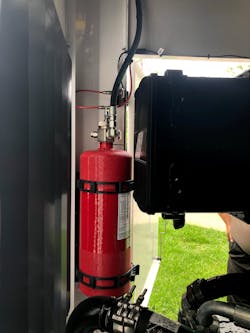Mitigate the Risk of Equipment Fires
With more than 20 fire incidents with equipment damage on the ramp going viral in the last three years, the aviation industry has taken notice. During the International Air Transport Association (IATA) committee meeting in March of this year, fires on the ramp were an item of discussion. Firetrace International was invited to the meeting to explain automatic fire suppression systems on ground support equipment (GSE) and how they benefit owners and operators.
Following the meeting, IATA decided to add language to the next publication of the Airport Handling Manual (AHM) on fire detection and suppression. The language intends to reduce the number and impact of fire incidents and will become effective on Jan. 1, 2020.
AHM 913, 19.3 - Due to potential safety risk to personnel and aircraft damage, it is advisable to consider the use of either a smoke and/or fire detection system or an on-board automatic fire suppression system coupled with automated shutdown on all equipment that interfaces with aircraft as well as other equipment.
The Impact of a Fire
With over 100,000 arrivals daily around the globe, a fire involving interfacing GSE has an immediate impact on airport operations. Anytime there is a fire on the ramp, ground crews, flight crews and passengers can be put in danger. A fire can leave critical GSE inoperable, airplanes out of service or in a worst-case scenario, a total hull loss. These scenarios can cause a ripple effect of delays and flight cancellations.
When a fire occurs in a piece of GSE, the operator has two choices – try to extinguish the fire or contact aircraft rescue and firefighting (ARFF) and wait until they can respond. If the operator chooses to attempt to extinguish the fire, they must first remember to perform shutdowns before exiting the equipment, grab the portable fire extinguisher, pull the pin, aim and release the fire extinguishing agent at the source of the fire. Gaining access to the source of the fire often involves opening or accessing compartments that would expose the operator to severe injury, therefore it should only be done by trained firefighters.
If the operator contacts ARFF and stands by, in the time it takes for first responders to get on-site, the fire could grow and cause severe damage to equipment or aircraft.
What are the Fire Risks?
According to a purchasing study conducted in 2019 by Ground Support Worldwide, nearly 50 percent of those surveyed said the average age of equipment in their GSE fleet was 10 years or older. The age of equipment and the demanding nature of their heavy use are contributing factors which make equipment more vulnerable to fire. Preventative maintenance programs address many issues from continual wear, but fire can remain a risk.
Equipment and vehicles with fuel-based engines can run for extended periods, which creates an extremely hot environment. While in operation, the lines for fuel, hydraulics and deicing liquid if necessary, keep the equipment running. These fluids are extremely flammable and if a line or fitting fails, the liquid can spray out onto the hot equipment causing a flash fire.
The electrical system presents multiple fire hazards. Batteries can be at risk of a fire if not properly secured and protected from the possibility of a short circuit. A battery can become a fire risk due to leaking or venting of hydrogen gas. In a confined space, like the battery compartment, hydrogen can hit a lower flammability limit of 4 percent quite quickly. Electrical wiring and connections can also be a hazard if not properly secured or damaged. They can create an arc or short circuit, causing a fire.
While preventive maintenance does reduce the risk of fire, it does not eliminate the risk, unfortunately. When a fire event does occur, an automatic fire suppression system can detect and suppress the fire before it has a chance to grow and cause catastrophic equipment damage or injury to individuals.
What is Automatic Fire Suppression?
An automatic fire suppression system detects a fire event, releases a suppression agent and shuts down the equipment to prevent a fire from spreading. There are two primary detection methods for automatic fire suppression systems – active and passive. Both are effective methods to detect fire.
An active system needs a power source to detect the fire by constantly monitoring for signs of heat or smoke. This requires connection to the vehicle battery or power supply, which can have a parasitic power draw on the equipment or uses a battery that must be monitored and replaced as needed. The drawback with active detection is the system’s inability to detect fire with a loss of power.
Passive fire detection systems like Firetrace do not rely on electricity. The system utilizes a pneumatic fire detection tubing in and around the area that has the fire hazard, like an engine compartment. When the detection tubing comes in contact with the heat and flames from a fire, the tube bursts, activating the pressure switch to initiate shutdown, as well as releasing the suppression agent through the distribution network. The distribution network consists of application-specific nozzle configurations to provide a total flooding of suppression agent as well as local application of the agent to the most hazardous parts of the equipment.
Choose a Suppression Agent
Automatic fire suppression systems have a variety of chemical agents to choose from to suppress the fire. Dry chemicals, clean agents and carbon dioxide are all proven and acceptable suppression agents for use on fires in different applications.
Multipurpose ABC dry chemical is very capable of extinguishing fire. However, the properties of the agent restrict its use in certain applications. ABC dry chemical is principally made from monoammonium-phosphate and is highly corrosive to aluminum. When using on a fire, it melts on contact with heated surfaces and is difficult to clean up from an airframe. Both NFPA Standards and the International Fire Code (IFC) do not allow ABC dry chemical extinguishers in airports at fueling areas, maintenance areas or on ramps due to the corrosive nature of the agent on aluminum aircraft components.
Wet chemicals have found some popularity due to the belief that they are safer on equipment. These chemicals have antifreeze compounds added to survive the environment typical to GSE. Antifreeze compounds have the drawback of being corrosive. Additionally, fires within GSE have hidden obstacles such as engines and equipment where fires can start. That can make it difficult for the wet agent to penetrate and suppress the fire.
Clean agents are practical for many applications because they are non-corrosive and leave no residue. They act on the fire tetrahedron by one of two principles: reduction of heat or inhibiting the chain reaction which suppresses the fire. Because of un-closable openings and air movement in GSE, it is difficult to maintain the amount of agent needed to suppress the fire.
Purple-K, also known as PKP, is a dry-chemical fire suppression agent and approved for use on the ramp. Purple-K is non-corrosive and works well in extreme environments. When released, the agent gets into the concealed areas where fires may be hiding. When it comes to choosing a suppression agent, Purple-K is a wise choice for GSE.
Installation Options
Fires can cause injury, loss of life and significant damages to ground support equipment. An automatic fire suppression system is an effective, safe and economical solution to mitigate fire risk. System installation is available either at the OEM level when purchasing a new piece of equipment or as a retrofit onto equipment already in service. Installation times vary based on the system and equipment and generally takes between four to eight hours. The process of installing a system begins with the design. Each piece of equipment goes through a review for optimal placement of the tubing, cylinder, manual release and automatic equipment shutdown which prevents reignition. After design, the system is professionally installed and commissioned. The installer will certify the system and the equipment is up and running.
In the Event of Fire
After a fire occurs in a piece of equipment, the first step is to clean up the suppression agent. Next is the replacement of the detection tubing and recharging of the cylinder. Once recharged, the professional installer will recertify the system and the equipment is ready for use. As with installation, getting the equipment back in working order will only take a few hours.
Assess Risk
Automatic fire suppression systems are not mandatory. When analyzing the cost with turn rate and considering the cost of downtime, it can be a prudent investment. Every type of GSE has some level of vulnerability and risk of fire. It is important to assess each type of equipment on the factors contributing to their risk. Installing a fire suppression system not only protects equipment but also provides a safer working environment for personnel and reduces the impact of fire.
Have you assessed the fire risks in your ground support equipment?
Steve Mulhall has more than 17 years of fire suppression industry experience. He has been instrumental in providing fire suppression systems for heavy equipment and vehicles systems in a variety of industries. He joined Firetrace International, a leader in fire suppression systems for micro-environments, in 2018 and is the business development manager for ground support equipment (GSE). He cultivates strong relationships with key industry stakeholders and consults with engineering to provide the best fire suppression solutions to address industry concerns. Learn more at firetrace.com/gse.




